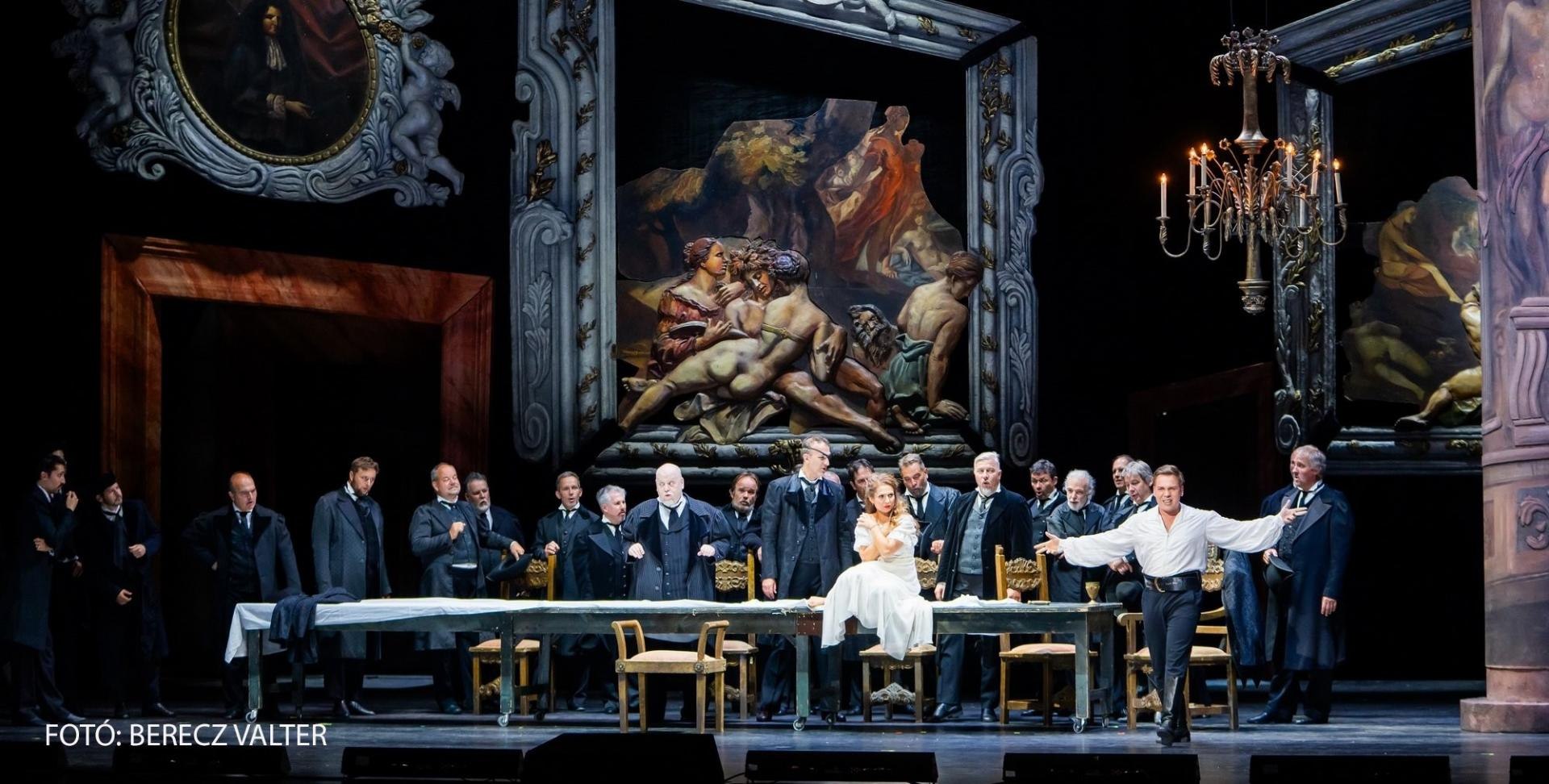Rigoletto
Mo | Tu | We | Th | Fr | Sa | Su |
Rigoletto – Giuseppe Verdi
Running time: 3 hours, including two intervals
Language: Italian
Surtitles: Hungarian, English, Italian
The lecherous noblemen of the Mantuan court must be entertained, and a deformed jester spares no one his jeers to ensure that they are. And yet he prays that the scathing mockery he heaps on the suffering of others will not return to haunt him. All he must do is seal his work off from his family life. But when his daughter, following her own heart, leaves the safety of those walls, Rigoletto's secret double life leads her to her doom.The popularity of Verdi's work is no accident: with Shakespearean profundity and thrilling music, it depicts a tragedy of acceptance and schadenfreude, love and self-sacrifice.
Age restriction: The performance is not recommended for children under 12 years of age.
Synopsis
Act 1
First scene
A hall in the ducal palace
The Duke of Mantua is boasting about his most recent adventure to the assembled nobles: he has made the acquaintance of a young well-to-do maiden of the city, whom he has approached dressed in the simple clothes of a student with the intention of seducing her. In the meantime, he is also not giving up his courtship of the wife of the Count of Ceprano: in spite of her husband's presence, he makes advances at her.
Rigoletto, the court fool, arrives and mocks the married couple, who are at the mercy of the duke's whims. Nearly all of the courtiers have fallen victim to the jester's sharp tongue at one time or another, and when Marullo arrives with the news that Rigoletto is keeping a lover, they all resolve to repay him for his many humiliations by abducting the girl. The Count of Monterone storms into the ball to call the duke to account for seducing his daughter, only to be caricatured by Rigoletto. Monterone curses the jester.
Second scene
Rigoletto's house and garden and the adjacent street
Rigoletto is terrified by Monterone's curse. On his way home, he is stopped by the assassin Sparafucile, who offers the jester his services. Rigoletto dismisses him and hurries home to his daughter, Gilda, whom he has raised sequestered away from the world in complete ignorance of her father’s name and profession. The girl, however, is concealing from him the fact that for months now she has been meeting with an unknown student, with whom she has fallen in love. The student is none other than the duke in disguise. After Rigoletto departs, the courtiers arrive with the aim of abducting the woman whom they believe to be the jester's lover. Rigoletto suddenly returns, and they convince him that they are trying to kidnap Countess Ceprano. Rigoletto takes part in the game, and only when it is too late does he realise that he has assisted in the abduction of his own daughter.
Act 2
A hall in the ducal palace
The courtiers offer up the kidnapped girl to the duke. Also arriving, overcome with despair, is Rigoletto: this time, however, he is the one who is mocked by the courtiers. The jester informs his daughter of her mysterious suitor's identity and true nature nature, but Gilda remains unmoved: she loves the duke. Rigoletto swears deadly revenge.
Act 3
By the River Mincio and Sparafucile's house
During the night, Rigoletto finds Sparafucile and hires him to murder the duke, but first he wants to disillusion Gilda with him. He forces her to watch as the duke courts Sparafucile's lovely younger sister, Maddalena. The confused and distraught Gilda is ordered by her father to put on men's clothing and head for Verona right away. The girl, nevertheless, returns to Sparafucile's house, where she finds out about her father's murderous plan. Fancying the prince, Maddalena asks her brother to spare his life and instead kill the first stranger who enters the inn. Gilda decides to sacrifice herself. Wearing men's clothes, she knocks on the gate and, upon entering, is mortally wounded. Sparafucile hands over a sack to Rigoletto, claiming that it contains the duke's dead body. Upon hearing the duke's voice in the distance, however, Rigoletto opens the sack and discovers his dying daughter inside it. Monterone's curse has thus been fulfilled.
Program and cast
Conductor - Péter Halász
Duke of Mantua - Andrei Danilov, Gergely Boncsér
Rigoletto - Michele Kalmandy, Alexandru Agache
Gilda - Zita Szemere, Laura Topolánszky
Sparafucile - István Rácz
Maddalena - Viktória Mester
Count Monterone - László Szvétek
Marullo - N. N.
Borsa - Attila Erdős
Count Ceprano - Dávid Dani
Countess Ceprano - Anija Lombard (opera studio)
Giovanna - Lusine Sahakyan
Page - N. N.
Court usher - Zoltán Bátki Fazekas
Featuring the Hungarian State Opera Orchestra and Chorus, as well as students of the Hungarian Dance University and the Hungarian National Ballet Institute
Director: Mária Harangi
Director: Miklós Szinetár
Set designer: Attila Csikós
Costume designer: Rita Velich
Choreographer: Jenő Lőcsei
Anna Varsányi's rough translation revised for use as subtitles by Eszter Orbán
English translation by Arthur Roger Crane
Chorus director: Gábor Csiki
Hungarian State Opera
STANDING ROOM TICKETS - INFORMATION IN CASE OF A FULL HOUSE!
If all the seats are sold out for the selected time, but you still want to see the production on that day, 84 of the extremely affordable standing seats will be sold at the theatre, 2 hours before the start of the performance, with which you can visit the gallery on the 3rd floor. Tickets can be purchased at the ticket office of the Budapest Opera House. We would like to draw your attention to the fact that the stage can only be seen to a limited extent from the standing places and the side seats, but at the same time, following the performance is also supported by television broadcasting on the spot.
The Opera House is not only one of the most significant art relic of Budapest, but the symbol of the Hungarian operatic tradition of more than three hundred years as well. The long-awaited moment in Hungarian opera life arrived on September 27, 1884, when, in the presence of Franz Joseph I. the Opera House was opened amid great pomp and ceremony. The event, however, erupted into a small scandal - the curious crowd broke into the entrance hall and overran the security guards in order to catch a glimpse of the splendid Palace on Sugar út. Designed by Mikós Ybl, a major figure of 19th century Hungarian architecture, the construction lived up to the highest expectations. Ornamentation included paintings and sculptures by leading figures of Hungarian art of the time: Károly Lotz, Bertalan Székely, Mór Than and Alajos Stróbl. The great bronze chandelier from Mainz and the stage machinery moda by the Asphaleia company of Vienna were both considered as cutting-edge technology at that time.
Many important artists were guests here including Gustav Mahler, the composer who was director in Budapest from 1887 to 1891. He founded the international prestige of the institution, performing Wagner operas as well as Magcagni’ Cavalleria Rusticana. The Hungarian State Opera has always maintained high professional standards, inviting international stars like Renée Fleming, Cecilia Bartoli, Monserrat Caballé, Placido Domingo, Luciano Pavarotti, José Cura, Thomas Hampson and Juan Diego Flórez to perform on its stage. The Hungarian cast include outstanding and renowed artists like Éva Marton, Ilona Tokody, Andrea Rost, Dénes Gulyás, Attila Fekete and Gábor Bretz.

 EN
EN DE
DE IT
IT FR
FR ES
ES RU
RU JP
JP RO
RO
 Seating plan
Seating plan 